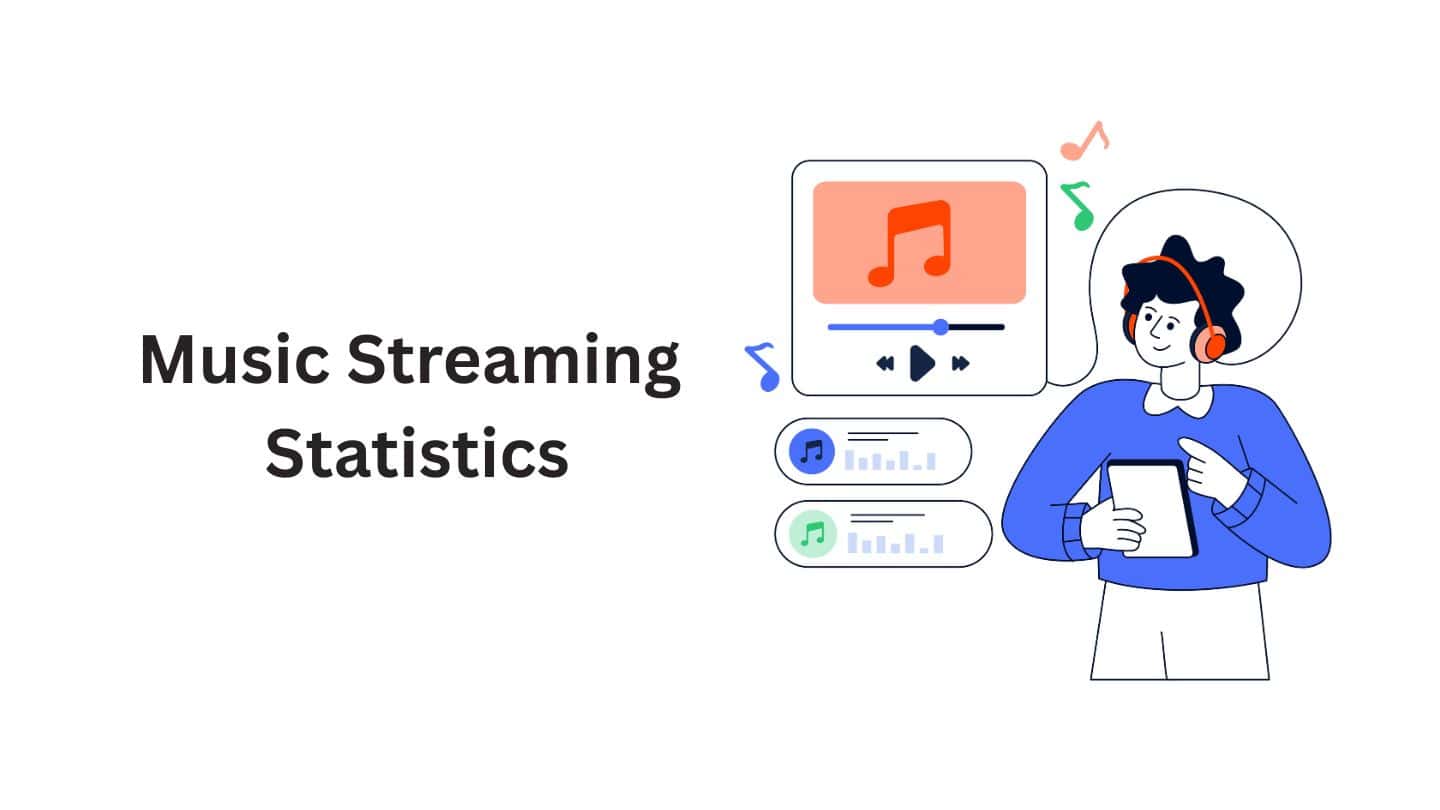Virtual Assistant Statistics By Major Key Players, Market Revenue, Users, Demographics, Trends And Growth

Updated · Nov 11, 2025


WHAT WE HAVE ON THIS PAGE
- Introduction
- Editor’s Choice
- Fun Facts
- Virtual Assistance Market Revenue
- Virtual Assistant Worldwide Users
- Virtual Assistant Market Size Worldwide
- Virtual Assistant Demographics
- Use Of Virtual Assistant By Locations
- Use Of a Virtual Assistant At Home
- Virtual Assistant Statistics By Major Key Players
- Virtual Assistant Employment Statistics
- Positive Impacts
- Technological Advancements And Trends
- Consumer Satisfaction And Challenges
- Conclusion
Introduction
Virtual Assistant Statistics: In recent years, a substantial expansion in the worldwide market for virtual assistants has occurred. This growth is attributed to developments in artificial intelligence (AI) as well as a surge in demand for automated customer support solutions. In 2023, global sales of virtual assistants amounted to around 12.4 billion US dollars despite having been valued at about 10.5 billion USD just one year earlier.
The latest increase represents an approximately 18% growth compared to 2022, reflecting an increasing uptake of these tools by various sectors such as retailing, healthcare, and finance, among others. Furthermore, by 2024, the sector’s worth is expected to increase further to USD 14.8 billion US dollars, growing at a compound rate of 19%.
This rise can be attributed mainly to the growing requirement for efficient customer service, cost-cutting measures and the augmented potentialities of AI-driven virtual assistants. This article will delve into significant information concerning the virtual assistant statistics sector as it stood in 2023 and what is anticipated for 2024, focusing mainly on figures from a market researcher’s perspective.
Editor’s Choice
- The Global Intelligent Virtual Assistant Statistics is poised to witness moderate growth with a CAGR of 35.1% from now until 2033.
- At a valuation of USD 15.3 billion in 2023, the industry will reach USD 309.9 billion by 2033.
- Employing virtual assistants enables companies to achieve up to 78% reduction in costs.
- According to predictions, virtual professionals will account for half of the US labor force by 2028.
- 28% of people aged between 18 and 29 are reported as actively interacting with virtual assistants.
- Usually ranging from USD 2 to USD 20 per hour, this is what virtual assistants normally earn.
- Most virtual assistants are paid per hour, which makes up for about 87%.
- Hiring them would cost around 78% less than having full-time employees who work face-to-face.
- In the United States, the average age of a virtual assistant is 40 years.
- Out of all well-remunerated officers, 35% use virtual assistant services.
- Virtual assistants are prevalent on billions of devices worldwide.
- By 2026, the United States will have over 150 million voice assistants.
- At first, they were introduced into phones before being widely accepted due to the availability of smart speakers. The introduction of the Amazon Echo in 2014 was a turning point for most homes that welcomed smart speakers.
- As of 2022, roughly 30% of American and British households use these devices daily.
- In the future, the number of smart speaker devices is expected to surpass 27 billion globally by 2028.
- Therefore, with this growth, smart speakers are projected to be Standard within every household; hence, the presence of virtual assistants is increasing within homes.
Fun Facts
- According to statistics, 31% of virtual assistants are hired by companies with employee numbers between 100 and 1000, while 49% are hired by those with an employee population above 1000.
- The main reason why most businesses employ virtual assistants is to cut costs since now 70% of companies use them.
- By 2027, it is expected that there will be approximately 86.5 million freelancers in the United States.
- In California and New York City primarily based states, the highest earnings for virtual assistants come from USD 7099.50 per month, followed by Fremont City with USD 6805, and then lastly, San Jose City, amounting to 6624 dollars only.
- Email communication and cold calling were the most requested services in 2023, while social media marketing services were also among the top demands in 2022.
- American workers experienced a 12% increase in productivity thanks to virtual assistants during 2022.
- As of March 2022, 140 million Americans used virtual assistants, thanks to the use of smart speakers and smartphones.
- International Virtual Assistant Day is celebrated every third Friday of May. This year (2022), it was May 20th, and it will be celebrated again on May 19th next year (2023).
Virtual Assistance Market Revenue
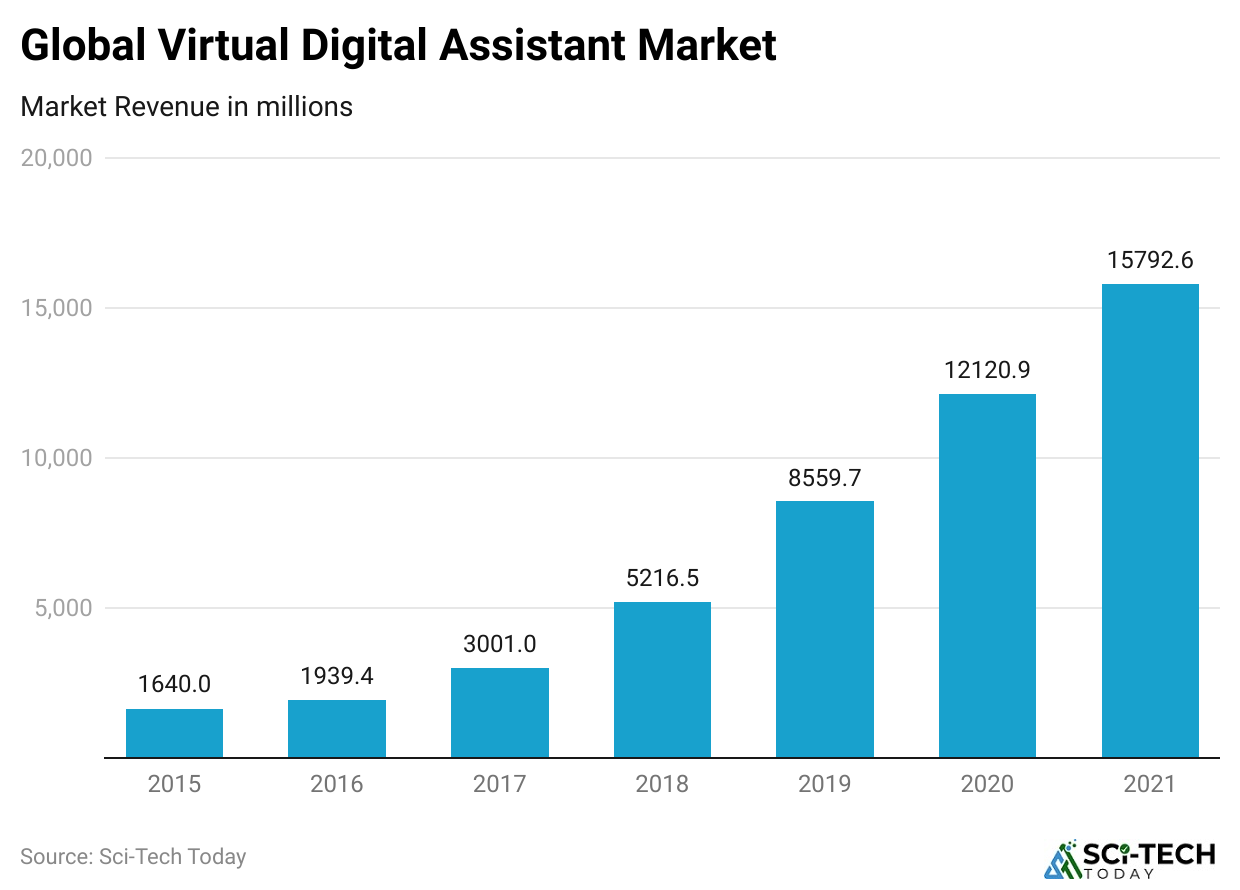
(Reference: scoop.market.us)
- Virtual assistant statistics have earned impressive revenue growth throughout the years. In 2015, revenue was estimated at around 1.64 billion dollars, while this number rose slightly to around 1.94 billion dollars in 2016.
- The next years witnessed an upsurge as revenues increased from about 3 billion dollars in 2017 to about 5.22 billion dollars the following year (2018).
- Continuing this upward trend throughout 2019, revenues reached nearly 8.56 billion dollars in value terms during the same period.
- In 2020, it expanded even more rapidly, recording an estimated total of nearly twelve point twelve billion dollars’ worth before exceeding fifteen point 79 billion dollars’ worth in the final year (2021). This steady increase reveals the growing application and use of virtual digital assistants across different fields.
Virtual Assistant Worldwide Users
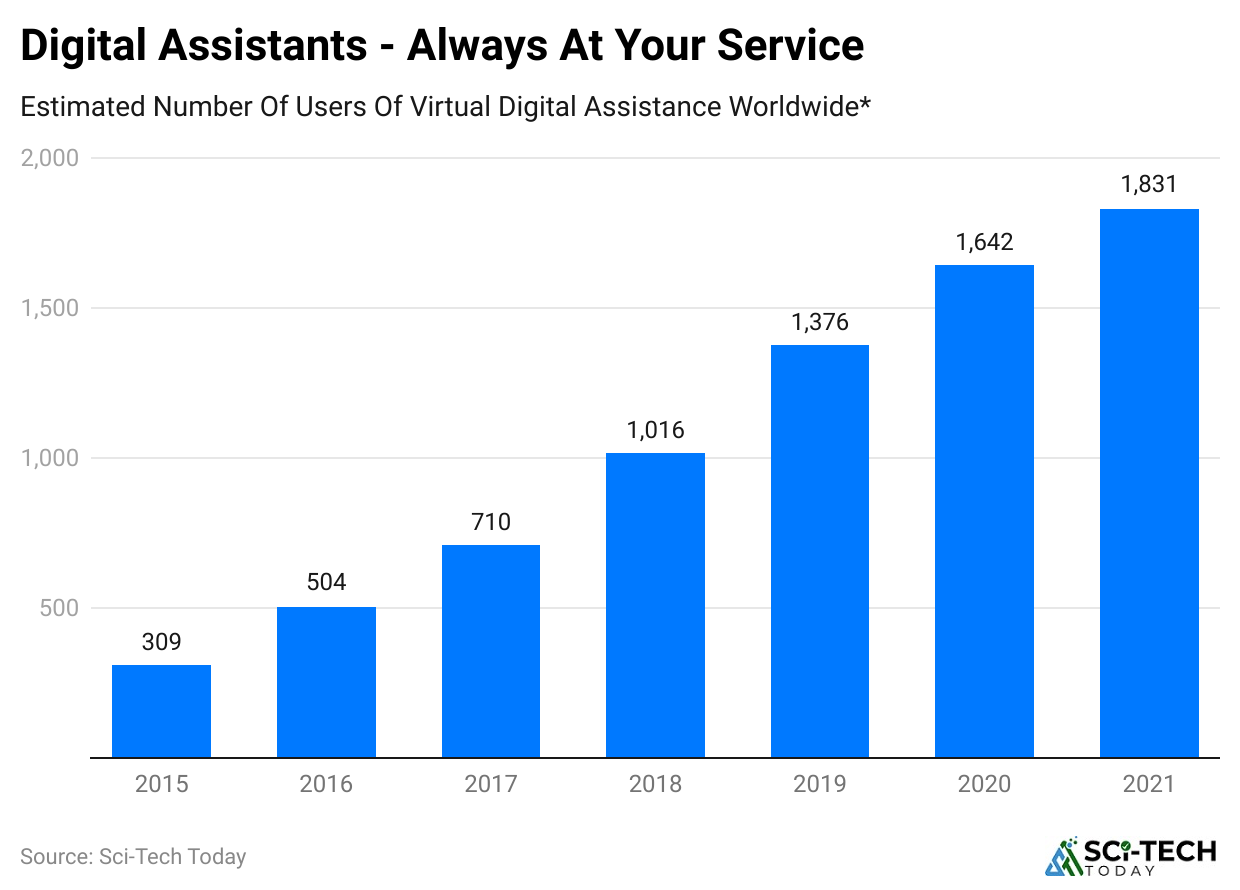
(Reference: statista.com)
- Virtual assistant statistics predict a dramatic increase in their use during the next few years. Their forecasts, for instance, indicate that digital assistant users will increase from 504 million this year to 1.8 billion by 2021.
- Although intelligent voice recognition is currently mainly associated with mobile phone applications such as Siri or Google Now, Tractica expects that comparable solutions will be incorporated into many other electronic devices.
- Amazon’s Echo—a multi-functional smart speaker —illustrates what such technology may do for homes in the immediate future.
Virtual Assistant Market Size Worldwide
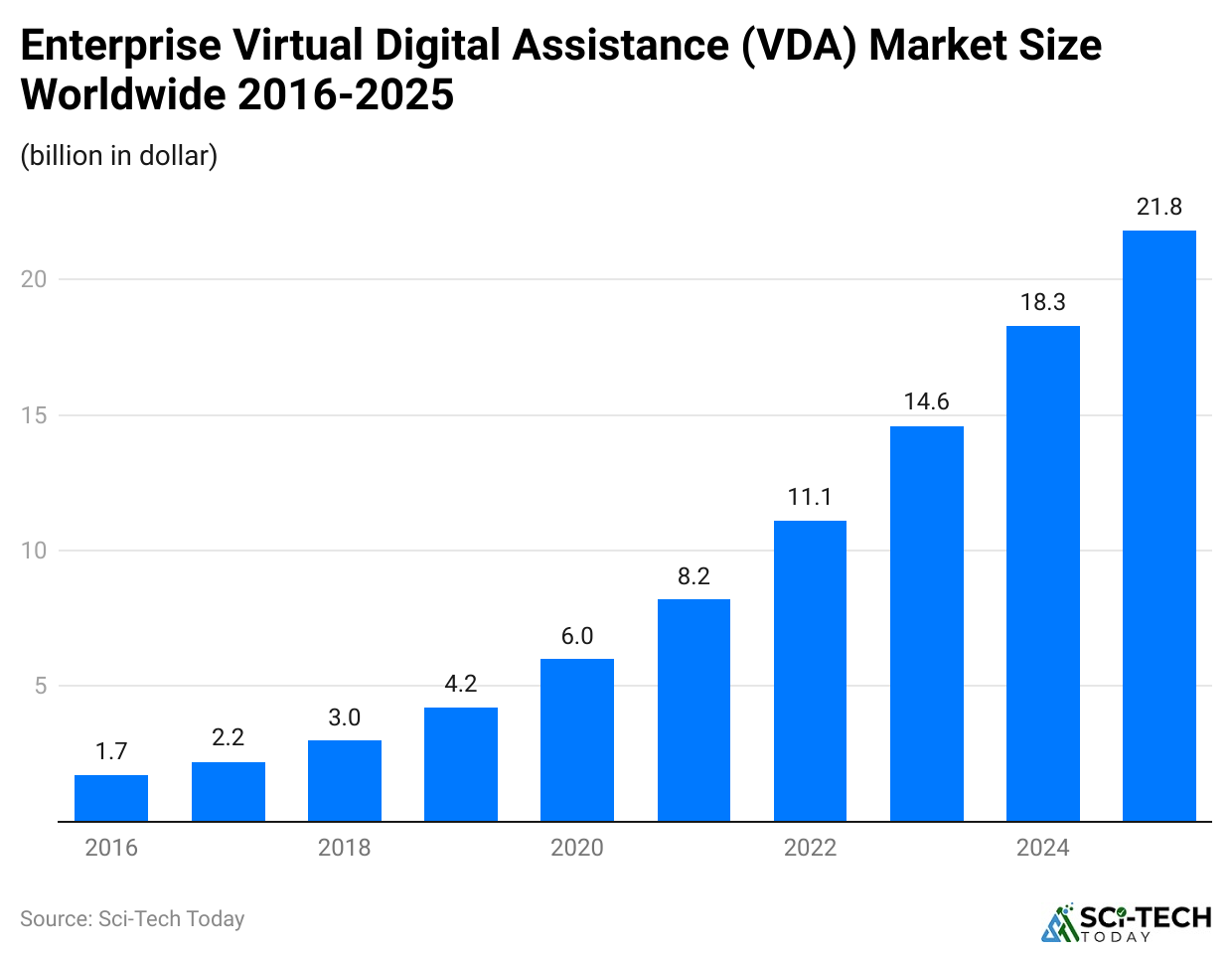
(Reference: statista.com)
- Virtual assistant statistics are expected to take off in the business world in the foreseeable future. According to a study from Tactica, the market for enterprise-wide digital assistants is expected to double in three years and triple within four years.
- The market size of virtual assistants will be USD 21.8 billion in 2025.
Virtual Assistant Demographics
- Virtual assistant statistics show that the US has the greater part (70.8%) of virtual assistants are Caucasian, followed by a minority of Hispanics at 14.8%, Africans at 8.7%, and Asians at 3.5%. Women dominate the virtual assistant profession with an overwhelming number, which accounts for 82.6% of the workforce. Although there has been a little rise in the number of males working in this area over the past ten years, it has yet to make much impact.
- A large percentage of virtual assistants (62.1%) speak two languages, with Spanish being the most frequently spoken second language. French is spoken by 8.6%, whereas 6.9% speak German, and 3.4% speak Portuguese or Japanese as their second language.
- About 60% hold bachelor’s degrees, which may not be necessary to succeed in this profession.
- The majority (78%) are more than forty years old, while only 16% are between thirty and forty years old; 6% are between twenty and thirty years old.
- Most are already married when starting this job because they have children. An estimate of about 69.3% of females married to their husbands, while 76.1% of mothers carry babies, suggests that people who want to make careers as virtual assistants need some emotional maturity since they are likely to be happy in their jobs as well.
Use Of Virtual Assistant By Locations
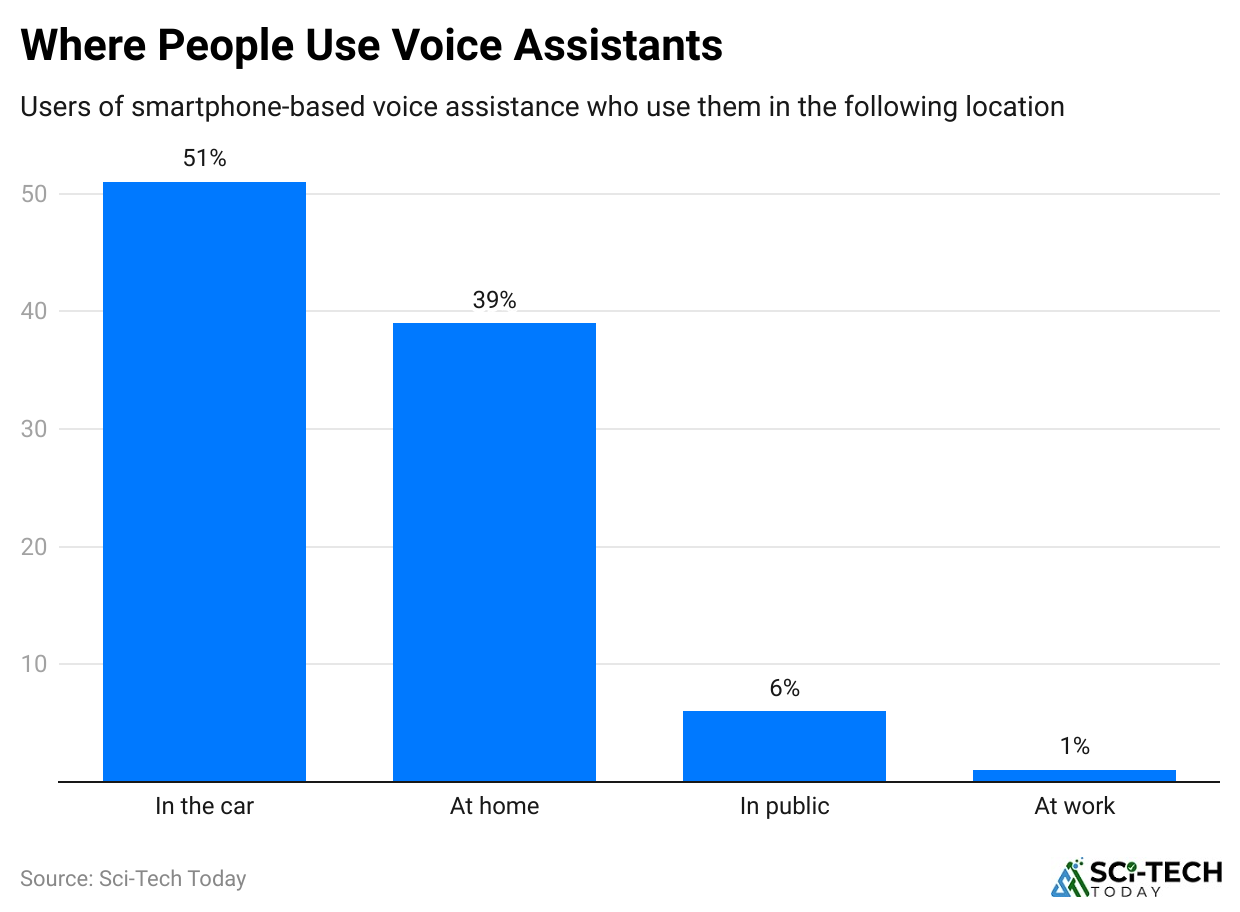
(Reference: statista.com)
- Most virtual assistant usage happens in cars, 51% of which are used for things like navigation, sending messages, or playing music hands-free, thus making driving safer and more convenient.
- Home is another major area where 39% of people use virtual assistants to control smart home devices, set reminders, answer questions, or do other routine jobs.
- The fewest people who use virtual assistants (about 6%) are those who do it openly, like near locations and quick information during calls without any physical contact with devices.
- The office is not a common place for virtual assistants because only 1% of users find it appropriate to use them for work purposes due to traditional tools that are preferred in such environments.
Use Of a Virtual Assistant At Home
- Virtual assistant statistics show that TVs are the most used devices for entertainment through these assistants, with a significant 58% usage rate.
- On the other hand, lighting control is a common usage area, with 36% of respondents employing virtual assistants to manage bulbs to create ambiance.
- In terms of climate control, 29% of respondents rely on virtual assistants to control thermostats, which help save energy.
- The other 26% include those who have incorporated such features into their alarm systems so as to enhance security.
- Virtual assistants are also used in home automation, with 22% using them to switch on/off appliances or control electric outlets and switches.
- Even the tiniest smart appliances are now being combined with virtual assistant technology to perform everyday chores more efficiently, as shown by 19% of respondents who use them this way.
- Moreover, 18% utilize virtual assistants to manage locks and garage doors, thus improving safety at home.
- Lastly, some people (16%) have installed these devices in their doorbells, indicating how versatile they can be in terms of different aspects of home equipment.
Virtual Assistant Statistics By Major Key Players
Amazon Alexa
- In America, Alexa is mostly preferred by 71.6 million people.
- In 2020, 10.8% of all who bought digitally did so using Alexa.
- Moreover, over four hundred million connected devices have been linked to Alexa, and most users control them weekly through their voice.
- It is estimated that Alexa can currently support over one hundred thousand smart home devices, compared to only four thousand in 2017.
Siri Voice Search Statistics
- Eight billion gadgets with voice support systems will emerge in 2023. By 2021, sales of smart speakers are anticipated to exceed tablet devices.
- With 65% of current users having both Alexa and Google Home, it is hard for them to imagine how they could live without this type of speaker.
- In this case, Cortana had less than 2% of the market share in America as of 2018 Microsoft’s console.
- They utilize sophisticated Artificial Intelligence (AI) technology to convert human speech into written content, such as Word documents.
Google Home Search Statistics
- According to the latest statistics, Google’s speech recognition service supports more than a hundred languages, an enhancement of over four hundred million devices today.
- In this regard, Google Home can provide accurate answers for 81% of questions asked by smart speakers, which implies a high level of accuracy.
Virtual Assistant Employment Statistics
- About virtual assistant statistics, 41% more people were hired in 2020 than in 2019 to work for virtual assistants through offshore agencies.
- Full-time employment accounted for 59% of these virtual assistants.
- Many organizations still perpetuate the traditional 9-to-5 office workday, although an increasing number are adopting remote work policies.
- Virtual assistant statistics indicate that 85% of remote workers stated that their productivity increased when they worked from home.
- Out of all developing countries, the Philippines is becoming the most preferred destination for hiring virtual assistants. This is mainly because its national average monthly charge is approximately USD 400, which attracts many Americans as well. Conversely, virtual assistants can earn as much as USD 4,000 per month in the US.
- Some virtual assistants promote this type of work because they are concerned about staying up-to-date with their assignments, while trends imply otherwise.
- Moreover, 20% of employers doubt if they will ever find capable people for their tasks, while 13% keep searching for new options.
- Virtual assistant statistics are reputed for reducing operating costs by a staggering 78%. In America, 75% of virtual assistants are aged forty and above. Also, 83% of virtual assistants are women, making the industry predominantly female.
- Virtual assistant statistics show that one out of every eight million virtual assistants on Upwork comes from the Philippines. Because they work with customers easily and have high literacy levels of 96.2%, Filipino virtual assistants are preferred globally by companies as they are the cheapest option.
Positive Impacts
- In the United States, the proportion of women to total employees working as virtual assistants by the year 2023 stood at 83%.
- According to Virtual Assistant Statistics, 84.4% of businesses report positive outcomes after hiring virtual assistants.
- This position has benefited virtual assistants’ lives positively, as echoed by 3.1% of business owners.
- By far, 93.1% of virtual assistants said they were happy with their job roles and would like to stay for an extended period.
- Furthermore, companies that used efficient virtual assistants experienced a steady decline in operational costs by 78% by 2022.
Technological Advancements And Trends
- The growth of AI and natural language processing (NLP) capabilities made the current transport capacity of computer-based assistants possible.
- Thus far, around 55% of them ran on advanced algorithms, allowing for more sophisticated operations, context understanding, and personalized answers. Since companies have started to invest heavily in AI-powered assistants, artificially intelligent conversations are predicted to increase by 60% within two years.
- One of the important trends for 2023 was using virtual helpers for customer service.
- In addition, 2023 saw a change since they handled 48%, rising from 42%.
- These projections suggest that by 2024, remote assistants will manage up to 52%.
- This happened because they are more efficient in answering many queries from clients and are also cheap.
Consumer Satisfaction And Challenges
- As of 2023, consumer satisfaction with virtual assistants was generally positive, with 70% of users reporting satisfaction with their interaction with them.
- This figure should slightly rise to 72% in 2024 due to virtual assistants’ increasing proficiency in understanding and responding to user requirements.
- Nevertheless, challenges persist. In 2023, 20% of users expressed frustration about virtual assistants’ limitations, particularly when it comes to understanding complex queries or giving accurate responses.
- This number is expected to decline to 18% by 2024 due to progress in AI and NLP, which have improved the performance of virtual assistants.
Conclusion
The virtual assistant statistics market is set for ongoing growth in 2024 because of technological progressions, more businesses making use of them, and rising consumer demands. In the year 2024, it is projected that this market will attain a value of USD 14.8 billion, thus making virtual assistants very important in areas like customer service, retailing, healthcare, and banking.
As AI technologies develop, the abilities of virtual assistants are going to increase, enabling them to offer better benefits to both commercial entities as well as end users.
Sources
FAQ.
The worldwide market value for virtual assistants was $12.4 billion in 2023, an 18% increase from the previous year. This market is expected to grow to $14.8 billion in 2024, with an estimated compound annual growth rate (CAGR) of around 19%.
Most companies hire virtual assistants to cut costs; some have reported a 78% decrease in their operating expenses. Moreover, they improve efficiency in customer service and administrative functions.
Many different devices and industries employ this type of technology. By 2026, there will be more than 150 million voice assistants alone in America. Additionally, it is anticipated that by 2025, the value of the enterprise market for virtual assistants will be approximately $21.8 billion.
In the U.S., 70.8% of virtual assistants are Caucasian, and 82.6% of the workforce is female. A significant portion (75%) are over the age of 40. Many virtual assistants are bilingual, with Spanish being the most common second language.
In 2023, 70% of consumers reported satisfaction with their virtual assistant interactions. However, 20% expressed frustration with the assistants’ limitations, particularly in understanding complex queries. This frustration is expected to decrease as AI and natural language processing (NLP) technologies improve.

Barry is a technology enthusiast with a passion for in-depth research on various technological topics. He meticulously gathers comprehensive statistics and facts to assist users. Barry's primary interest lies in understanding the intricacies of software and creating content that highlights its value. When not evaluating applications or programs, Barry enjoys experimenting with new healthy recipes, practicing yoga, meditating, or taking nature walks with his child.








